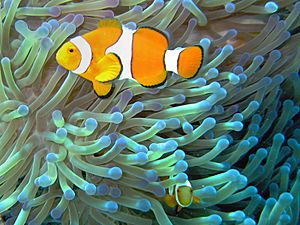Cooperation facts for kids

Cooperation, co-operation, or coöperation is the process of working or acting together, which can be accomplished by both intentional and non-intentional agents. In its simplest form it involves things working in harmony, side by side, while in its more complicated forms, it can involve something as complex as the inner workings of a human being or even the social patterns of a nation. It is the alternative to working separately in competition. Cooperation can also be accomplished by computers, which can handle shared resources simultaneously, while sharing processor time.
It is is the process of groups of organisms working or acting together for common or mutual benefit, as opposed to working in competition for selfish benefit. Many animal and plant species cooperate both with other members of their own species and with members of other species (symbiosis or mutualism).
Cooperation, more formally speaking is how the components of a system work together to achieve the global properties. In other words, individual components that appear to be “selfish” and independent work together to create a highly complex, greater-than-the-sum-of-its-parts system. Examples can be found all around us. The components in a cell work together to keep it living. Cells work together and communicate to produce multicellular organisms.
Organisms form food chains and ecosystems. People form families, gangs, cities and nations. Neurons create thought and consciousness. Atoms cooperate in a simple way, by combining to make up molecules. Understanding the mechanisms that create cooperating agents in a system is one of the most important and least well understood phenomena in nature, though there has not been a lack of effort.
However, cooperation may be coerced (forced), voluntary (freely chosen), or even unintentional, and consequently individuals and groups might cooperate even though they have almost nothing in common qua interests or goals. Examples of that can be found in market trade, military wars, families, workplaces, schools and prisons, and more generally any institution or organisation of which individuals are part (out of own choice, by law, or forced).
Contents
The basics of cooperation
An analysis of the multiple scholarly writings and field studies on cooperation as it develops within groups and organizations reveal that it rests on four functional variables: 1) flexibility or the ability to adapt to other people's needs 2) consideration or the willingness to take other people's opinions and feelings into account; 3) exchange of information 4) joint problem resolution.
The first two variables are considered to be emotional because they are experienced as such and the last two are considered to be cognitive because they involve some level of rationalization,.
Kin selection
One specific form of cooperation in animals is kin selection, which can be defined as animals helping to rear a relative’s offspring in order to enhance their own fitness.
Cooperative systems
Cooperation is a process by which the components of a system work together to achieve the global properties. In other words, individual components that appear to be "selfish" and independent work together to create a highly complex, greater-than-the-sum-of-its-parts system. Examples:
- The components in a cell work together to keep it living.
- Neurons create thought and consciousness, other cells work together and communicate to produce multicellular organisms.
- Organisms form food chains and ecosystems.
- People form families, tribes, cities and nations.
- Atoms cooperate in a simple way, by combining to make up molecules.
Understanding the mechanisms that create cooperating agents in a system is one of the most important and least well understood phenomena in nature, though there has not been a lack of effort.
Individual action on behalf of a larger system may be coerced (forced), voluntary (freely chosen), or even unintentional, and consequently individuals and groups might act in concert even though they have almost nothing in common as regards interests or goals. Examples of that can be found in market trade, military wars, families, workplaces, schools and prisons, and more generally any institution or organization of which individuals are part (out of own choice, by law, or forced).
Cooperation vs. competition
While cooperation is the antithesis of competition, the need or desire to compete with others is a common impetus that motivates individuals to organize into a group and cooperate with each other in order to form a stronger competitive force.
Cooperation in many areas, such as farming and housing, may be in the form of a cooperative or, alternately, in the form of a conventional business. Many people resort to this because, they may cooperate by trading with each other or by altruistic sharing.
Certain forms of cooperation are illegal in some jurisdictions because they alter the nature of access by others to economic or other resources. Thus, cooperation in the form of cartels or price-fixing may be illegal.
See also
 In Spanish: Cooperación para niños
In Spanish: Cooperación para niños

